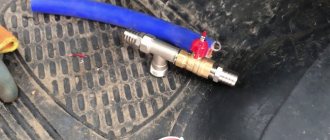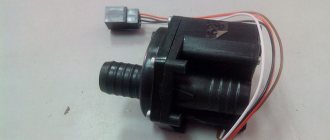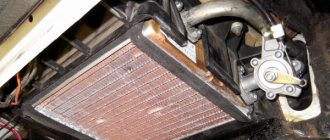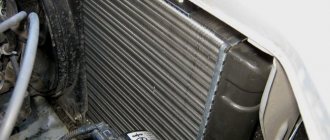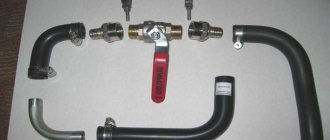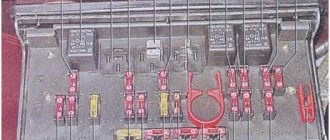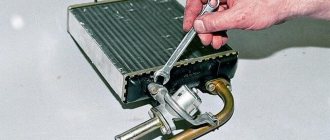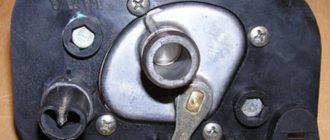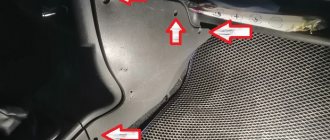The importance and benefits of the interior heating system are felt only in the cold season. When summer comes, the need to use the system disappears. But, as you know, you need to prepare a sleigh in the summer. In the summer, daylight hours are longer, and the weather is conducive to quick and high-quality repairs. First you need to understand how the heating system in a car is designed and functions. On a Gazelle Business car, as on all cars with a liquid-cooled engine, a stove is installed, into which heat is supplied from the heated parts of the engine through coolant. The liquid heats the heater radiator, the fan blows air, which, passing through the honeycombs, heats up and spreads throughout the cabin. Gazelle Business stoves are equipped with an electronic control unit that can control the heater both automatically and manually. To do this, it has a cabin temperature sensor that allows you to maintain the set temperature. All adjustments are electric, and not on cables, as in previous versions. The dampers are controlled by gearmotors, and the temperature is controlled by an electric valve (reducing or increasing the amount of coolant passing through the radiator). All controls are placed on the front panel, which is very convenient and does not distract the driver from driving the car. But any equipment sooner or later malfunctions.
What is an electric heater valve?
Electric heater valve (heater control valve with electric drive, heater valve) is a component of the vehicle interior/cabin heating system; a tap or valve to control the supply of coolant from the engine cooling system to the heater radiator (heat exchanger).
An electrically operated faucet is similar to a mechanical faucet, but is driven by a built-in electric motor or solenoid. This solution made it possible to abandon the cable drive and implement control of the heater using a button. Electric cranes make it possible to implement various schemes for heating the interior and operating the engine cooling system, while they are easy to use, reliable in operation and have a simple design.
Installing a new one
Installation of a new radiator:
Before removing the stove, it is advisable to obtain new pipes for connecting it in advance and replace them along with the radiator.
This is due to the fact that they may lose their original characteristics during operation, and replacing them separately is an additional financial and time expense.
Replacing a heater heater in a passenger car is a labor-intensive process and often takes a lot of time. To avoid constant repairs of this nature, only original and high-quality parts should be installed on the car, and only reliable and proven materials should be used as coolant. It is advisable to diagnose the heating system before the onset of the cold season, so as not to have problems with it in the winter.
Winter cold is coming soon, so every motorist should thoroughly prepare their car.
To begin with, remember the following rule: the heating system of the car interior directly depends on the operation of the cooling system. Therefore, if there is something wrong with the stove, then the search for problems should start from there.
A car's cooling system runs on antifreeze, and as your car ages, the cooling system develops leaks. And a poorly heating stove is confirmation that there are certain problems with the cooling system.
Solving this problem is quite simple: add antifreeze to the expansion tank to about. However, keep in mind: before removing the cap from the reservoir, be sure to wait until the engine has completely cooled down!
The next possible problem with the stove is a faulty thermostat. This problem is somewhat more complex, since the thermostat is a very important component that regulates engine temperature, while it also controls the flow of coolant. And if the thermostat does not work correctly (or does not work at all), then the heated antifreeze simply cannot get into the stove. It is for this reason that it can be cold in the cabin. The solution to the problem in this case is simple: change the thermostat.
And one more case: the stove seems to be warmed up, but no warm air comes out of it. The problem here is a faulty fan of your stove, but such a breakdown should only be repaired by a service center.
If your car is 3-4 years old, then the cause of a weak heater may be a clogged cabin filter, or the heater radiator (we have already written about that in another material). As a rule, in these cases, the air coming out of the deflectors on the dashboard is barely warm, even if you turn the regulator to “maximum”. What can you do? Yes, everything is very simple: you need to replace the cabin filter. And it is advisable if you do it yourself, because it is not difficult and anyone can do it.
As for cleaning the stove, you shouldn’t take risks: it’s better to entrust this task to the service technicians. There, the work will be done efficiently, and you will receive a guarantee.
In general, in order to avoid all these troubles with the stove, you should just carefully monitor the car and promptly change those spare parts that are working at the limit of their capabilities.
With the onset of cold weather, car owners can often encounter a very unpleasant situation when, after turning on the heater, the interior does not begin to fill with warm air, although the regulator and blowing force are set to maximum power. There are many reasons why it may happen that the stove does not heat. To solve this problem, it is necessary to correctly diagnose the breakdown.
Check the serviceability of the elements responsible for the temperature in the car to prevent it from completely freezing
Types, design and operating principle of electric heater valve
Electrically controlled faucets existing today are divided into groups according to the type of shut-off element and its drive, and according to the number of circuits (and, accordingly, pipes).
Based on the number of circuits and pipes, heater valves are:
- Single-circuit / 2-pipe - ordinary taps / valves;
- Double-circuit / 3-pipe - three-way valves.
Double-port valves are valves that can only open and close the flow of liquid. In such a faucet, one pipe is inlet, the second is outlet, and between them there is a shut-off element. The dual-port heater valve is used in conventional interior heating systems and is located between the engine cooling system outlet and the heater core inlet to control the flow of hot coolant.
Three-way valves are three-way valves that can direct fluid flow into two different pipelines. This faucet has one inlet and two outlets, and the shut-off element is designed in such a way that it can direct liquid from the inlet to one of the outlets while simultaneously blocking the other. A heater valve with three pipes can be used in various interior heating systems: with bypass, with an additional heater, etc.
According to the type of shut-off element and its drive, taps are:
- Gate valves driven by an electric motor;
- Shut-off valves driven by a solenoid.
The design of gate valves is simple. They are based on a plastic molded body with pipes, inside of which there is a rotating plate in the form of a solid sector or a sector with holes the size of the pipes. A compact electric motor with a simple gear reducer is installed on the housing, with the help of which the plate rotates. In faucets with two nozzles (double-circuit), both nozzles are located opposite each other, with a plate between them. Three-way faucets have an inlet on one side and two outlets on the other.
The heater valve with an electric motor works as follows. When the heater is turned off, the valve plate is located between the pipes, blocking the flow of liquid - in this case, hot liquid does not flow into the heater radiator, and the interior heating system does not work. If it is necessary to turn on the stove, the driver presses a button on the dashboard, current is supplied to the electric motor of the faucet, it turns the plate and opens the path of coolant - the heater radiator heats up, the interior heating system begins to work. To turn off the heater, the driver presses the button again, all processes occur in reverse order, and the heater turns off.
A heater tap with three pipes also works easily if there is a bypass in the heating system. When the heater is turned off, the rotary plate is in such a position that the coolant passes through the tap and through the exhaust pipe enters the inlet of the engine cooling system (to the pump). When the heater is turned on, the plate rotates, closes one outlet pipe and opens the second - now the fluid flow freely passes into the heater radiator, and from it enters the exhaust pipe and the inlet of the engine cooling system. When the stove is turned off, all processes occur in reverse order.
The design of shut-off solenoid valves is different. They are based on a plastic case, inside of which there is a lifting valve in the form of a truncated cone. In the closed position, the valve sits on its seat, blocking the flow of liquid. The valve is connected via a rod to the solenoid armature, which is mounted on the valve body. Double-circuit valves can be single- or double-solenoid. In the first case, both locking elements are located on the solenoid rod, in the second, each locking element is controlled by its own solenoid.
The operation of the heater solenoid valve is also simple. The valves are normally open - without voltage on the solenoid, the valve is raised by a spring, the channel is open. When the engine starts, voltage is applied to the solenoid and the valve closes. When the stove is turned on, the solenoid is de-energized, the tap opens and supplies hot liquid to the heating radiator. When the stove is turned off, voltage is supplied to the solenoid again and the tap closes. A dual-circuit valve works in a similar way, however, one of its circuits is always closed when the ignition is turned on - this prevents the supply of coolant to the heater radiator; the liquid flows through the bypass. When the heater is turned on, the circuits switch, the coolant flows to the heater radiator, and when the heater is turned off, the valve returns to its original position. Both solenoids of a double-circuit valve never open or close at the same time (except during a complete blackout, when both valves are open).
The tap pipes of all types are serrated; this shape ensures a tight fit of the rubber pipelines. Installation of pipelines on branch pipes is carried out using metal clamps; the tap itself usually hangs freely on the pipelines (since it has a low mass). The tap is connected to the electrical system using a standard electrical connector.
Today, electric heater taps are widely used on domestic and foreign cars; they have practically replaced their mechanical counterparts and made control of the interior heater more convenient.
On the gazelle, the stove stopped blowing hot air, error code E3, E6, E7 lights up
The owner of a long gazelle business came to us from the distant northern Urals, the city of Novy Urengoy, with a complaint about a faulty stove, he says the stove doesn’t heat at all, but he bought this workhorse second-hand the other day and didn’t check the functionality of the stove, so we need to figure out the fault. Errors E3 and E7 (E3 and E7) light up on the display.
And so, we begin the check with a visual inspection of the heater control unit (HCU) 2705-8121020. E3 lights up on the display . Looking ahead, let's say that this malfunction is associated with the heater damper gear motor (90.3780) or MP-2-01 , which is located next to the driver’s right foot under the panel. Looking under the panel and deciding to check whether both connectors were latched, we did not find this gear motor, but only the connectors were dangling. Apparently the previous owner removed the gear motor, but did not install a new one. We install a new gear motor.
Video. Checking the heater damper gear motor (90.3780) or MP-2-01 .
2 errors with this gear motor ( 90.3780 ) E3 - malfunction of the damper position sensor ( rheostat ), which determines the current position of the damper. E6 - a malfunction of the motor itself, the gear motor that controls the damper.
We check the functionality of the heater and turn on the ignition. Error E3 disappeared, but error E7 . The stove still blows cold air, although the gear motor 90.3780 is working properly. Next, we check the heater tap, because it is responsible for supplying hot coolant to the heater radiator, and it is also the reason why error E7 . We set the temperature regulator on the control unit to the hottest position and check by hand the hoses going to the heater radiator.
Both of our pipes going to the heater radiator turned out to be cold, although the pump is working and the supply hose to the faucet is hot, which means for some reason the faucet does not open. The easiest way to check the operation of the faucet is to turn the temperature control to maximum and minimum with the car turned off. The stove tap should make characteristic clicks, indicating its operation. But we didn’t hear any sounds, so we’re conducting a more detailed check. We start by checking the heater tap connector.
First, let's check the +12 volt power supply (orange tap wire, white wiring connector wire), ground (black tap wire and black connector wiring wire) and control signals arriving at the heater tap: brown tap (brown wiring connector) - heat, white tap (green connector wiring) - cold.
For clarity and to check the operation of the control unit, we will assemble a simple probe using LEDs. It will clearly show us whether cold/heat control signals are being supplied from the control unit.
If one of the control signals is missing, then you should check the wiring from the heater tap to the control unit - these are the green and brown wires. In our case, there was no control signal on the brown wire, which is responsible for the heat supply.
When the ignition is turned on and the heater tap is connected, the green and brown wires should have a voltage of about +10. +12 volts coming from the heater tap. At the time of heat/cold adjustment, a control minus should appear on one of these wires. If there is no control signal, then the control transistor in the control unit itself has burned out. To check the control transistors, you need to disassemble the climate system unit and check the control keys.
The blue transistor is responsible for switching to the cold position, the red transistor is responsible for controlling the hot position
In our case, the red control key, which is responsible for the heat supply, was faulty.
After replacing the faulty transistor, the heater valve began to work as it should, error E7 disappeared, and the interior of our gazelle began to warm up
Questions about choosing and replacing a heater tap
The heater valve is very important for the operation of the interior/cabin heating system, however, selecting and replacing this part in most cases does not cause any problems. To select the right faucet, you must follow several recommendations:
- The power supply voltage of the crane motor must correspond to the voltage of the vehicle’s on-board electrical network - 12 or 24 V;
- The type of tap - 2 or 3 pipes - must correspond to the interior heating system diagram. For conventional systems, a tap with two pipes is required; for systems with bypass, a tap with three pipes is required. Also, a tap with three pipes can be used to create a heating system with an additional heater;
- The diameter of the pipes must correspond to the diameter of the heating system pipelines, but if necessary, adapters can be used;
- The faucet and vehicle must have the same type of electrical connector. If necessary, it is necessary to replace the type of connector on the vehicle;
- The crane must have dimensions suitable for its installation.
The heater valve must be replaced after draining the coolant; metal clamps must be used for installation. It is necessary to ensure that the tap is installed correctly - position its inlet and outlet pipes in accordance with the direction of the liquid. For convenience, there are arrows on the nozzles indicating the direction of fluid flow. If you install a regular 2-pipe valve incorrectly, the system will work, but incorrectly installing a 3-pipe valve will make the system completely inoperable. If the faucet is installed correctly and reliably, the stove will start working immediately, providing warmth and comfort in the car interior.
Diagnostics
If signs of malfunction or malfunction are detected, it is necessary to carry out diagnostics to identify the causes of the breakdown. One of the reasons why the heater begins to heat worse, or when very cold air comes out of it, is the valve of the Gazelle stove. It either does not open completely or is completely closed. If any of these signs occur, you must first check the correct operation of the electric crane.
- With the engine warm, touch the pipes before and after the electric valve. In the extreme hot position of the temperature adjustment handle, the pipe before and after the electric tap should be the same temperature.
- Check the power supply to the electric valve when switching temperatures.
- If there is no power, check the fuse and replace if necessary.
- Check the strainer on the inlet pipe; liquid should flow freely through the holes.
- When the tap is removed and the power is connected, you need to look into it through the light. When changing the position of the temperature regulator (from minimum to maximum), ensure that the shutter is fully opened when the handle is in the hottest position.
Heater heater valve
The car heater heater valve is one of the simplest parts of the car heating mechanism from a technical point of view. However, the failure of the faucet is quite unpleasant, since in the midst of cold weather you can be left without heating the interior, or, conversely, in the warm season the stove will “fry to the fullest.” Of course, you can replace the faucet at any car service center, but you can also fix the problem yourself.
The heater valve is a regulator of the flow of coolant flowing through the heater radiator of the car. The heater valve is controlled by a lever on the front console - in the warm season, when heating the car interior is not needed, the valve is closed with a lever, and the coolant bypasses the heater radiator. In winter, the lever is placed in the right position. In this case, the coolant, passing through the heater radiator, heats the air supplied by the fan, which allows heating the car interior.
Preventive actions
In winter, the stove in the car performs a vital function. In order for it to function normally and not break, you must follow several recommendations.
Periodically check the serviceability of the car at a service station; this will allow you to find and fix problems in advance.
Preventive measures
, and also remember that the performance of a car’s heating system directly depends on its age. The older the car, the more attention you need to pay to it.
To make the stove heat better:
The exact breakdown of the heating system can be determined by checking the main components. Depending on the make and age of the car, there may be other design changes, but the basic elements are more or less the same. That is why it is better to check the most common causes of heating failure in a car. Why the car heater does not work:
An experienced car enthusiast can fix many problems on his own. It is also worth noting that a faulty stove is not only an inconvenience for the driver and passengers, but also a threat to the condition of the car. If warm air is not supplied in sufficient volume, the glass in the cabin freezes, it is impossible to open the doors, and the engine itself is subjected to serious stress. Over time, such situations negatively affect the condition of the car and lead to the failure of many systems.
Where is the heater valve located?
The car heater valve is located under the center console of the car. In most cars it is located on the right side of the console closer to the passenger seat, but in some models it is located on the driver's side. You can get to the tap by removing the plastic cover of the dashboard and removing the mat.
However, access from the passenger compartment will not allow removing the heater tap. Depending on the car model, the tap can be reached from under the bottom of the car (in most older cars) or directly from the engine compartment.
The design of the stove heater valve and the principle of operation
The faucet is attached to the stove radiator using bolts. Using a lever and a control cable, the faucet is connected to a lever on the front panel. By switching the interior lever to the blue or red zone, the motorist opens or closes the tap. Using hoses extending into the engine compartment, the faucet is connected to the general engine cooling system. It is through the hoses that coolant flows into the heater radiator.
When the valve is open, the coolant passes through the heater radiator and heats its metal surface. The air forced by the fan is heated from the surface and warms the interior.
Types of stove heater taps
There are several types of heater taps suitable for one car model.
- Standard factory plastic faucet with a rubber membrane as a locking mechanism. As is often the case with domestic car models of past years, this crane is the least expensive and the most unreliable. Such a faucet “likes” to oxidize, stick and rust.
- Ball valve. In such a unit, instead of a rubber membrane, a ball with holes is installed. This design of the part is much more reliable, but still does not prevent oxidation. The cost of a ball valve is much higher than a standard factory one.
- The ceramic heater tap consists of a plastic body and two ceramic plates that perform shut-off functions. The most reliable option for a stove heater tap, however, due to the low throughput of a ceramic tap, its heat transfer is low. In addition, ceramic taps are prone to leaks. A ceramic tap is the most expensive option for stove heater taps.
Heater heater valve malfunction
Since the tap is not used during the warm season, when turning on the stove during cold weather, the driver may encounter a malfunction. There are three main problems with the heater valve.
- Faucet souring due to prolonged non-use of the stove during the warm season. In spring, summer and autumn, the stove is used only for air ventilation, so the tap switch lever is moved to the extreme left position. During this period, the faucet damper may become sour, which makes it impossible to turn on the stove. In the early stages, the malfunction is manifested by a weak supply of hot air, even with the damper open as much as possible. If you use excessive force when the faucet turns sour, you can completely break it. The malfunction cannot be called critical, but it must be eliminated before the winter cold.
- Faucet leakage due to depressurization of the body, when the O-rings and seals wear out, which leads to incomplete closure of the faucet. The consequence of this is a decrease in the level of coolant in the tank and, accordingly, in the entire engine cooling system. A leaking faucet is manifested by wet spots on the carpet, the smell of antifreeze in the cabin, and a grease mark on the bottom of the windshield.
- Faucet jamming with antifreeze decomposition products and other debris. The malfunction manifests itself in a similar way to a souring faucet, but its cause is different. Antifreeze deposits and dirt accumulating in the faucet mechanism lead to jamming of the faucet, which makes it impossible to regulate the level of liquid entering the heater radiator.
If souring and jamming of the faucet is a serious, but not critical breakdown, then it is better to fix the malfunction associated with the leaking faucet as soon as possible. Otherwise, due to a decrease in the coolant level, the entire cooling system of the car’s engine may suffer.
System modernization
The main problem that causes electronics to fail is moisture. And in the tap the liquid circulates constantly, even when the shutter is closed. And when the oil seal leaks, liquid floods the entire electrical part, and it fails.
Installation of shut-off valves
To avoid this, you can install conventional shut-off valves, fitting them to the outlets of the cooling system. But in order to open or close the supply of hot liquid, you need to move the tap to the desired position manually. And since it is installed under the hood (in a regular place), it is not possible to do this while driving. But this mechanism has a much greater resource.
Pre-sealing
Before installing a new electric faucet, you need to disassemble it and fill the electronic board with hot glue to avoid moisture getting on it, coat all joints with sealant. This method can only prolong performance, because if liquid gets into the electronic part, the electric motor will be damaged, without which the mechanism will not be able to function correctly.
Prevention of malfunction of the heater valve
Preventative maintenance of the heater valve allows you to prevent early failure of the mechanism. In order not to be left with a non-working stove before the start of the “heating season”, it is necessary to switch the lever from the red zone to the blue zone and back from time to time. This will prevent the heater tap from souring and jamming.
It is also necessary to carefully monitor coolant leaks in the car interior - for example, from time to time lift the rugs and examine the floor of the car for stains from leaking coolant.
Replacing the heater valve
The heater valve mechanism is so simple that it cannot be repaired. The malfunction can be eliminated by replacing the assembly part itself. To do this, you will have to work hard, since replacing a faucet requires access to it both from the interior and from the engine compartment and from under the bottom of the car.
- First you need to place the car on a flat surface. You need to place an empty container under the radiator into which you can drain the coolant from the radiator.
- Next, you need to move the container under the car engine and drain the “coolant” from the engine. To do this, you need to unscrew the special bolt on the block on the left side.
- Then you need to loosen the screws of the clamps from the engine compartment that secure the hoses connecting the faucet to the engine cooling system. After this, the hoses must be removed from the tap pipes.
- After this, you need to loosen the screws of the hose clamps on the tap side. To do this, you will have to go into the car interior and remove the plastic dashboard cover. After the screws have been loosened, you need to remove the hoses where they are attached to the heater radiator.
- From the engine compartment, unscrew the nuts holding the valve.
- After this, the faucet can be removed from the car interior. All that remains is to disconnect the rod connecting the crane to the control lever on the front console. To do this, using pliers, you need to disconnect the bracket on which the rod is attached. After this, the tap can be finally removed.
Installing a new heater tap is done in the reverse order, except for one thing. First, the hoses connecting the faucet to the engine cooling system are connected, and only then the bracket and rod are installed. After this, coolant can be added to the system.
Repair
Once it has been determined that the electric crane is faulty, it must be dismantled. For this:
- Drain the coolant from the vehicle's cooling system into a prepared container.
- Disconnect the terminals from the heater electric valve.
- Loosen the clamps on the pipes and disconnect them.
- Disassemble and determine the causes of failure. There may be several of them:
- the electric motor has failed;
- the electrical board has burned out;
- the gearbox for opening and closing the shutter has failed;
- the oil seal has leaked;
- the body burst.
- If it is possible to replace parts without replacing the entire mechanism, then such an action would be advisable if you have spare parts in stock or can purchase them for little money. Because, having changed one of the parts, with a high degree of probability you can expect that the other one will soon fail. Of course, it is better to replace the entire element assembly, but this is not always possible.
Heater Gazelle business principle of operation.
The Gazelle Business heater is not a bad parody of foreign car heaters, but only at first glance. The heater is controlled by buttons and knobs on the electronic unit located on the control panel. The air in the heater, as on all Gazelles, is sucked in by an electric fan through the grilles under the windshield and, passing through air ducts and deflectors, enters the cabin. Coolant is supplied to the heater radiator through a tap, the opening and closing of which is carried out by an electric drive. It is distinguished from the same taps of previous models by the presence of an additional fitting. When the valve is closed, the liquid is redirected back to the cooling system.
Clogged radiator
Over time, scale forms in the radiator, which creates plugs. The obstruction of the lines leads to a decrease in the pressure that supplies warm air. At high speeds there may be an increase, but at idle you won’t get any warmth. What to do? Theoretically, you can try flushing the radiator yourself. Many auto stores offer special mixtures that destroy salt compounds. But purging and flushing will only work if the lines are not completely clogged. If there is no circulation in one of the pipes, then it will not be possible to flush it. Replacement only. Advice may also include checking the thermostat, replacing the filter (if available), and the gasket. But in practice, the stove does not heat up at idle in 90% of cases precisely because of the high wear of the radiator . To avoid such problems, it is recommended to take preventive measures in time. Use a high-quality cooling mixture, change it regularly, monitor the quality (after draining, for any impurities), do not mix several models of antifreeze. Operate your car competently and enjoy a warm car in winter.
Heater Gazelle business device.
The tap is controlled automatically by the heater control unit depending on the selected temperature. In addition, the temperature of the air supplied to the cabin is regulated by a central damper, which, by turning, directs the air flow, or part of it, through or bypassing the radiator. In addition to the central damper, there are a number of dampers that redistribute the air flow. The dampers of the Gazelle Business heater, unlike previous models, are controlled by gear motors, not cables. The control is carried out by the heater control unit. The electric heater fan is located inside the housing and to access it it is necessary to remove and disassemble the entire heater. Despite the fact that the fan electric motor is imported, this arrangement completely negates all the advantages of the heater.
The speed of the electric motor is regulated smoothly by turning the handle on the control unit, due to the electronic regulator located on the heater body. To access it, as well as access to almost all elements
heater, it is necessary to remove the front panel completely. The only thing that can be changed without removing the panel is the heater core. To change it, just remove the glove compartment.
